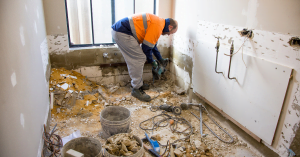Navigating the owner builder process and building your dream home can be a fulfilling experience, but it can also be daunting. As an owner builder, you are accountable for managing the complete construction process from start to finish. Including obtaining permits, hiring contractors, overseeing the project, and ensuring everything is up to code. It can be overwhelming, particularly if you have little to no experience with construction. However, with suitable preparation and guidance, you can successfully navigate the owner builder process and bring your dream home to life. This article will explore the critical steps involved in the owner builder process, including getting permits, hiring contractors, managing the project, and ensuring compliance with building codes. We will also provide ideas and best practices to help you overcome common challenges and ensure a smooth and successful construction journey. So, let’s keep reading!
An owner builder is a person who takes on the onus of building their own home. They are responsible for attaining the necessary permits, hiring contractors, overseeing the construction, and ensuring the project is completed on time and budget. Owner builders can either do the work themselves or hire trades to do the work for them.
Being an owner builder requires a certain level of dedication and commitment. It can be a pleasing experience and a time-consuming and challenging process. With the proper preparation and guidance, anyone can successfully navigate the owner builder process, but no one said it would be easy.
There are various benefits to being an owner builder. First and foremost, you have total control over the design and construction of your home. You get to make all the choices, from the type of materials used to the layout of the rooms. This level of control ensures that the final product is what you envisioned.
Another benefit of being an owner builder is that you can save money. By hiring contractors directly or doing some of the work yourself, you can avoid paying the markup that general contractors typically charge. You may have significant cost savings.
Finally, being an owner builder can be a great learning experience. You will gain beneficial knowledge and skills to apply to future projects. You will also be more thankful for the construction process and the work of building a home.

The owner builder process can be broken down into several key steps. These steps include obtaining permits and approvals, building your team, budgeting, project management, and ensuring compliance with building codes. Let’s take an in-depth look at each of these steps.
Before starting your home construction, you must get the essential permits and approvals from your local building department. Getting an early start is essential because this can be complex and time-consuming.
The first step is determining what permits and approvals are required for your project. This can hinge on many factors, including the location of your property, the size of your home, the scope of your construction project and town planning requirements.
Once you have determined the required permits and approvals, you must apply to your local building department. This application will typically include detailed plans and specifications for your project and information about the contractors and suppliers you will use.
After you have submitted your application, the building department will review it. They may request additional information or revisions to your plans before issuing the necessary permits and approvals.
Building a home requires a crew of professionals, including architects, contractors, and suppliers. As an owner builder, choosing the right team members is essential to ensure that your project is concluded on time, on budget, and to your satisfaction.
When selecting an architect, look for someone with experience designing homes like yours. Ask for references and a portfolio of their work from previous clients.
When hiring contractors, it’s essential to do your due diligence. Check their references and credentials, and ensure they have experience working on projects like yours. You should also obtain multiple quotes from different trades to ensure that you are getting a fair price. Ensure these quotes are like for like so you can compare them easily.
Finally, when selecting suppliers, choose companies with a good reputation for quality and reliability. Consider the cost and availability of the needed materials.
Budgeting and financial management are one of the most momentous aspects of being an owner builder. A realistic budget and sticking to it throughout construction are essential.
When creating a budget, include all the costs associated with your project, including permits, materials, labour, and professional fees. You should also factor in a contingency fund for unexpected expenses.
To manage your finances, make sure you track your expenses, manage your cash flow, and stay within your budget.

An owner builder manages the construction process, including creating a checklist (project schedule), coordinating with contractors and suppliers, and overseeing the work.
When creating a checklist (project schedule), be sure to factor in all the tasks that need to be completed, including obtaining permits, ordering materials, and completing construction. You should also scrutinise any potential delays or setbacks and add extra time to account for them.
Consider using project management software such as Owner Builder Workflow or hiring a project manager to ensure your project stays on track. Helping you stay organised, communicate with your team, and track progress throughout construction.
A top priority is safety when building a home. Ensuring that all work complies with building codes and safety regulations is essential for an owner builder. An owner builder site is a work site.
Before starting construction, ensure you have obtained all necessary permits and approvals. You should also ensure that all contractors and suppliers are licensed and insured.
During construction, follow all safety protocols and provide appropriate safety equipment to your team. You should also conduct regular safety inspections and have toolbox meetings to identify and address potential hazards.
Owner builders may encounter some common problems during construction despite careful planning and preparation. These may include budget overruns, delays, and quality issues.
To address these problems, it’s crucial to have a contingency plan in place. This may involve adjusting your project schedule, revising your budget, or bringing in additional resources to address quality issues. An option is to have Owner Builder Coach as your backup and support throughout the whole build.
Maintaining open communication with your team throughout the construction process is essential. Help you identify and address problems early on before they become significant issues.

Owner building your home can be a rewarding but challenging experience. An owner builder manages every aspect of the construction process, from obtaining permits to overseeing the work. Following the vital steps outlined in this article, you can successfully navigate the owner builder process and bring your dream home to life. Remember to stay organised, communicate with your team, and prioritise safety throughout construction. With the proper preparation and guidance, anyone can be a successful owner builder. Remember, we have your back with Owner Builder Coach and Owner Builder Workflow.